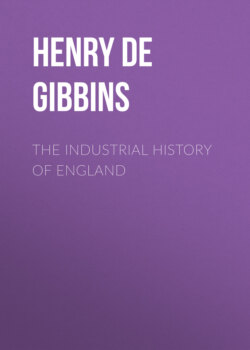Читать книгу The Industrial History of England - Henry de Beltgens Gibbins - Страница 19
На сайте Литреса книга снята с продажи.
§ 12. The kinds of land in a manor
Оглавление—Before concluding this chapter, it is necessary, in order to complete our {20} sketch of the manorial system from the time of the Conquest onwards, to understand how the land was divided up. We may say that there were seven kinds of land altogether, (1) First came the lord’s land round about the manor-house, the demesne land, which was strictly his own, and generally cultivated by himself or his bailiff. All other land held by tenants was called land in villeinage. (2) Next came the arable land of the village held by the tenants in common fields. Now these fields were all divided up into many strips, and tenants held their strips generally in quite different places, all mixed up anyhow (cf. diagram, where the tenants are marked A, B. C, etc.). The lord and the parson might also have a few strips in these fields. There were at least three fields, in order to allow the rotation of crops mentioned before (p. 8). Each tenant held his strip only till harvest, after which all fences and divisions were taken away, and the cattle turned out to feed on the stubble. (3) Thirdly came the common pasture, for all the tenants. But each tenant was restricted or stinted in the number of cattle that he might pasture, lest he should put on too many, and thus not leave enough food for his neighbours’ cattle. Sometimes, however, we find pasture without stint, as in Port Meadow at Oxford to this day. (4) Then comes the forest or woodland, as in Estone, which belonged to the lord, who owned all the timber. But the tenants had rights, such as the right of lopping and topping certain trees, collecting fallen branches for fuel; and the right of “pannage”—i.e. of turning cattle, especially swine, into the woods to pick up what food they could. (5) There was also in most manors what is called the waste—i.e. uncultivated—land, affording rough pasture, and on which the tenants had the right of cutting turf and bracken for fuel and fodder. Then near the stream there would {21}
DIAGRAM OF A MANOR
THE KING (supreme landlord)
TENANT IN CHIEF, owning various manors.
A SUB-TENANT, or tenant in mesne, the lord of the manor below.
perhaps be some (6) Meadow land, as at Cuxham; but this always belonged to the lord, and if he let it out, he always charged an extra rent (say eightpence instead of sixpence an acre), for it was very valuable as affording a good supply of hay for the winter. Lastly, if the tenant could afford it, and wanted to have other land besides the common fields, where he could let his cattle lie, or to cultivate the ground more carefully, he could occupy (7) a close, or a portion of land specially marked off and let separately. The lord always had a close on his demesne, and the chief tenants would generally have one or two as well. The close land was of course rented more highly than land in the common fields.
The accompanying diagram shows a typical manor, held by a sub-tenant from a tenant in chief, who holds it of the king. It contains all the different kinds of land, though of course they did not always exist all in one manor. It also shows the manor-house, church, mill and village.14
14 See note 5, p. 244, on Decay of Manorial System.
